Transport in Jakarta
As a metropolitan area of about 30 million people, Jakarta has a variety of transport systems.[1] Jakarta was awarded 2021 global Sustainable Transport Award (STA) for integrated public transportation system.[2]
 Jakarta pedestrians, joggers and bicyclists take over the main avenue during Car-Free Day | |
| Overview | |
|---|---|
| Locale | Jabodetabek |
| Transit type | Commuter rail, metro, light metro, bus rapid transit and bus, angkot, taxicab, motorcycle taxi, bajaj, private automobile, bicycle, pedestrian |
The city prioritised development of road networks, which were mostly designed to accommodate private vehicles.[3] A notable feature of Jakarta's present road system is the toll road network. Composed of an inner and outer ring road and five toll roads radiating outwards, the network provides inner as well as outer city connections. An 'odd-even' policy limits road use to cars with either odd or even-numbered registration plates on a particular day as a transitional measure to alleviate traffic congestion until the future introduction of electronic road pricing.
There are many bus terminals in the city, from where buses operate on numerous routes to connect neighborhoods within the city limit, to other areas of Greater Jakarta area and to cities across the island of Java. The biggest of the bus terminal is Pulo Gebang Bus Terminal, which is arguably the largest of its kind in Southeast Asia.[4] Main terminus for long distance train services are Gambir and Pasar Senen. High-speed railways being constructed connecting Jakarta to Bandung and another one is at planning stage from Jakarta to Surabaya.
Rapid transit in Greater Jakarta consists of TransJakarta bus rapid transit, Jakarta LRT, Jakarta MRT, Greater Jakarta Commuter Rail, and Soekarno-Hatta Airport Rail Link. Another transit system Greater Jakarta LRT is expected to be operational by early 2021.
Privately owned bus systems like Kopaja, MetroMini, Mayasari Bakti and PPD also provide important services for Jakarta commuters with numerous routes throughout the city. Pedicabs are banned from the city for causing traffic congestion. Bajaj auto rickshaw provide local transportation in the back streets of some parts of the city. Angkot microbuses also play a major role in road transport of Jakarta. Taxicabs and ojeks (motorcycle taxis) are available in the city.
Soekarno–Hatta International Airport (CGK) is the main airport serving the Greater Jakarta area, while Halim Perdanakusuma Airport (HLP) accommodates private and low-cost domestic flights. Other airports in the Jakarta metropolitan area include Pondok Cabe Airport and an airfield on Pulau Panjang, part of the Thousand Island archipelago.
Indonesia's busiest and Jakarta's main seaport Tanjung Priok serves many ferry connections to different parts of Indonesia.The old port Sunda Kelapa only accommodate pinisi, a traditional two masted wooden sailing ship serving inter-island freight service in the archipelago. Muara Angke Port is used as a public port to Thousand Islands (Indonesia), while Marina Ancol Port is used as a tourist port.[5]
Usage shares
As of 2015, about 1.4 million commuters travel into the city centre from the outskirts of Jakarta. Based on the survey, 58 percent of these commuters use motorcycles, 12.8 percent use cars and only 27 percent use public transportation.[6] In 2004, a study was undertaken to prepare a master-plan for an integrated public transport system within Greater Jakarta, which revealed the mode of transport among city dwellers.[7][8] The city's 9.5% average annual growth rate of motorized vehicles far exceeds the 0.01% increase in road length between 2005 and 2010. As of 2010, public transportation in Jakarta serves only 56% of commuter trips. [8]
| Transport mode | No. trips (thousands) | % share |
|---|---|---|
| Walking | 14,073 | 37.7 |
| Angkot (small bus) | 7,818 | 20.9 |
| Motorcycle | 4,890 | 13.1 |
| Sedan/MPV/SUV | 2,783 | 7.5 |
| Medium Bus | 2,012 | 5.4 |
| Large Bus | 1,224 | 3.3 |
| Ojek (Motorcycle taxi) | 1,073 | 2.9 |
| Bicycle | 787 | 2.1 |
| School/Company bus | 466 | 1.2 |
| Economy Train | 434 | 1.2 |
| Patas AC (Bus) | 422 | 1.1 |
| Colt/Mini Cab | 298 | 0.8 |
| Omprengan | 295 | 0.8 |
| Bajaj | 217 | 0.6 |
| Becak | 202 | 0.5 |
| Pick Up | 131 | 0.4 |
| Taxi | 126 | 0.3 |
| Express Train | 39 | 0.1 |
| Truck | 33 | 0.1 |
| Other | 8 | 0.0 |
| Total | 37,330 | 100 |
Road transport
Streets and highways
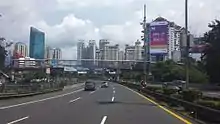
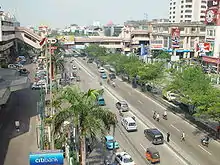
A structured road network had been developed in the early 19th century as a part of the Java Great Post Road by former Governor-General Daendels, which connects most major cities throughout Java. During the following decades, the road network was expanded to a great extent, although it could not keep up with the rapidly increasing numbers of motorised vehicles, resulting in highly congested traffic.[1][9] The city prioritised development of road networks, which were mostly designed to accommodate private vehicles.[3]
A notable feature of Jakarta's present road system is the toll road network. Composed of an inner and outer ring road and six toll roads radiating outwards, the network provides inner as well as outer city connections. Jakarta Outer Ring Road 2 is an under-construction toll road encircling greater Jakarta area, parallel with Jakarta Outer Ring Road (JORR 1).
The six radiating toll roads are:
- Prof. Dr. Ir. Soedijatmo Toll Road linking to Soekarno–Hatta International Airport
- Jakarta–Tangerang Toll Road linking to Tangerang and further to Merak in the west
- Jakarta–Serpong Toll Road linking to Serpong
- Depok-Antasari Toll Road linking to Depok and planned to go further to Bogor
- Jagorawi Toll Road linking to Bogor and Ciawi in the south
- Jakarta–Cikampek Toll Road linking to Bekasi and Cikampek in the east
The city's 9.5% average annual growth rate of motorised vehicles far exceeded the 0.01% increase in road length between 2005 and 2010. In 2018, over 13 million motorcycles and 4.4 million cars used the roads of Jakarta.[10] In 2019, there were about 88 million movements per day in the Greater Jakarta area,[11] and public transportation accounts for only 30% of commuter trips.[12] According to the National Development Planning Agency (Bappenas) traffic congestion in Greater Jakarta causes a waste of about $7.4 billion each year.[13]
Throughout the years, several attempts have been made to reduce traffic congestion on Jakarta's main arteries. Implemented solutions include a 'three-in-one' rush-hour law, during which cars with fewer than three passengers are prohibited from driving on the main avenues. However, "car jockeys" were paid by commuters to ride into the centre of the city to permit the use of three-in-one roads.[14] Another example is the ban on trucks passing main avenues during the day.[15] In 2016, 'odd-even' policy was introduced which designated cars with either odd or even-numbered registration plates on a particular day.[16] This aims to function as a transitional measure to alleviate traffic congestion until the future introduction of Electronic Road Pricing which would be more effective.[17]
Due to the city's acute gridlock, the Jakarta administration has decided to implement Electronic Road Pricing in 10 districts: Tanah Abang, Menteng, Setiabudi, Tebet, Matraman, Senen, Gambir, Tambora, Sawah Besar and Taman Sari.[18] The ERP is planned to be implemented in the three-in-one zone and along Jl. Rasuna Said. The ERP system is expected to be operational by 2019 along with the opening of the Jakarta MRT.[19] Implementation of the ERP system is planned to take place in two phases; the first will be for vehicles moving from the Senayan traffic circle to the Hotel Indonesia traffic circle while the second will be installed from the HI traffic circle to Jl. Medan Merdeka Barat.[20]
Bus service
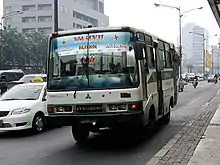
There are many bus terminals in the city, from where buses operate on numerous routes to connect neighborhoods within the city limit, to other areas of Greater Jakarta area and to cities across the island of Java. The biggest of the bus terminal is Pulo Gebang Bus Terminal, which is arguably the largest of its kind in Southeast Asia.[21] Besides TransJakarta, other private owned bus systems like Kopaja, MetroMini, Mayasari Bakti and PPD also provide important services for Jakarta commuters with numerous routes throughout the city. Since January 2013, Jakarta Government has integrated Kopaja AC buses with TransJakarta feeder bus routes. For the future, Metromini AC bus it is also possible to enter TransJakarta bus lanes to enhance integrated bus rapid transit system.
Traditional transports
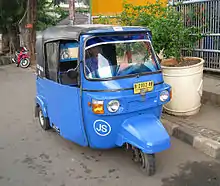
In 1966, an estimated 160 thousand pedicabs (becak) operated in the city; as much as 15% of Jakarta's total workforce was engaged in becak driving. In 1971, becaks were banned from major roads, and shortly thereafter the government attempted a total ban, which substantially reduced their numbers but did not eliminate them. A campaign to eliminate them succeeded in 1990 and 1991, but during the economic crisis of 1998, some returned amid less effective government attempts to control them.[22] Becaks were banned because they caused traffic congestion and they were seen as the exploitation of humans by other humans.[23] Becaks were replaced by bemo, betor, helicak, minicar, and bajaj.[23] In 2018, Governor Anies Baswedan attempted to allow becaks again because of a political contract with becak drivers during his campaign.[24] Most cycle rickshaw drivers in the 1980s were former landless agricultural laborers from rural areas of Java.[22] As of March 2018, there are about 1,500 becaks in Jakarta.[25]
Bajaj auto rickshaw provide local transportation in the back streets of some parts of the city. From the early 1940s to 1991 they were a common form of local transportation in the city. They are colored blue (for the ones which use Compressed natural gas) and orange (for the ones which use normal gasoline fuel).[26] The blue ones are imported from India with the brand of Bajaj and TVS and the orange ones are the old design from 1990. The government is currently replacing the orange bajajs with the blue ones because blue bajajs are less polluting and the gas fuel is cheaper.[26][27] Bemo was a three-wheeled vehicle similar to bajaj, which were eliminated in 1996 because they were old, too dangerous and cause much pollution, but they continued to exist until recently,[28] when in 2017, Bajaj Qute was introduced to replace bemo.[29] Angkot microbuses also play a major role in road transport of Jakarta. They operates in numerous routes to connect neighbourhoods of the city.
Taxi cab
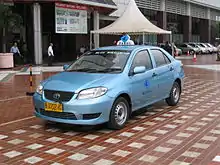
Plenty of taxi cabs are available in the city. Many companies operate & maintain pools of different model of cars in their own brands. Go-Jek and Grab also have wide presence. Vehicle for hire companies accessible by mobile apps, known in Indonesia as taksi online (online taxi), has reduced the number of conventional taxi companies operating in Jakarta from 32 to 4 (Blue Bird, Express, Gamya, and Taxiku).[30]
Motorcycle taxi/ojek
Although ojek are not an official form of public transport, they can be found throughout Indonesia and in Jakarta. They are especially useful when navigating crowded urban roads, narrow alleyways, heavy traffic and cramped locations that larger vehicles cannot reach. Most of the ojeks are operated by Go-Jek and Grab, in Indonesia called ojek online. Go-Jek was founded in 2011 so that ojek drivers who had been working with unpredictable income could operate professionally with better income, and its app was created in 2015.[31]
Bicycle
There are bicycle taxis (ojek sepeda ontel) in the Kota Tua (Old City) region. However, the revenues are declining because of the popularity of ojek online.[32] As of November 2019, Jakarta has 63 kilometres of separate bicycle lane, which will be extended to 200 kilometres by 2020.[33] Bicycle-sharing company Gowes, which means "to paddle," in Indonesian, started operation in limited areas of Jakarta in 2018.[34]
Intercity Rail
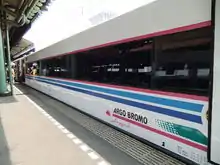
Long-distance railways and local tram services were first introduced during the Dutch colonial era. While the trams were replaced with buses in the post-colonial era, long-distance railways continued to connect the city to its neighbouring regions as well as cities throughout the island of Java. Main terminus for long distance train services are Gambir and Pasar Senen. High-speed railways are planned connecting Jakarta-Bandung and Jakarta-Surabaya.
High speed rail
The first high-speed rail to connect Jakarta with Bandung is currently under construction which is expected to start operation in 2021. The contract was awarded to China. Both Japan and China contested as a potential contractor, but it was awarded to China mainly because of their proposal did not require Indonesian fiscal spending or government debt guarantees.[35] The project cost was estimated to be US$5.5 billion. China Development Bank will fund 75 percent of the project. A joint venture company PT Kereta Cepat Indonesia-China has formed by China Railway Group Limited (CREC) with a consortium of Indonesia's state-owned enterprises (SOEs) led by PT Wijaya Karya Tbk to develop the project.[36]
Another project to upgrade of existing Jakarta-Surabaya route to high speed rail is undertaken in 2016. Priority was given to Japan this time who had been one of the biggest investors to Indonesia. The route is supposed to finish construction in 2019.[37]
Rapid transit
At present rapid transit in Greater Jakarta consists of a BRT TransJakarta, the Jakarta MRT, and commuter rail, Greater Jakarta Commuter Rail and Soekarno-Hatta Airport Rail Link. Other transit systems, those are now being under construction are Jakarta LRT and Greater Jakarta LRT.
Bus rapid transit
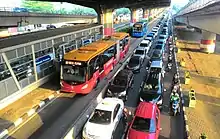
TransJakarta bus rapid transit service (known as Busway) was developed in the context of development reforms (or reformasi) and used Bogota's TransMilenio system as a model.[38] Jakarta's first busway line, from Blok M to Jakarta Kota opened in January 2004 and as of 14 February 2013, twelve out of fifteen corridors are in use. TransJakarta has the world's longest bus rapid transit routes (230.9 kilometres (143.5 mi) in length).[39][40] TransJakarta had a total of 128 routes as of April 2018 (corridor, cross route & feeder route) - a significant increase from 41 routes in 2015. TransJakarta has targeted to serve one million passengers per day by the end of 2018.[41] In addition there are 18 'feeder' routes that serve beyond the exclusive busway corridors. Located in the municipalities surrounding Jakarta, the feeder service uses special buses that allow for boarding at either ground level or the TransJakarta station platforms. Transjakarta owned more than 1,500 buses in the first three months of 2017 and targets to have 3,000 buses by the end of the year.[42]
Greater Jakarta Commuter rail
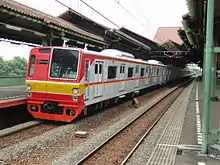
Greater Jakarta Commuter Rail or commonly known as Commuterline is a commuter rail system which serves commuters in Jakarta, Bogor, Depok, Tangerang, South Tangerang, and Bekasi. The commuter system was started in 2000.[43] The number of passengers in 2014 reached 208 million, rising from 158 million in the previous year.[44] Commuter Line serves all municipalities in Jakarta excluding the Thousand Islands, as well as Greater Jakarta region. The rail system uses rolling stock of rapid transit standard and operates at high frequency with a minimum headway. Daily ridership average was about 0.95 million [45] with total 315.8 million commuters used Commuter LineL Jabodetabek in the year of 2017.[46]
Major rail stations of commuter line are Jakarta Kota, Jatinegara, Tanah Abang, Duri, Pasar Senen, Manggarai and Sudirman. As a transit station, the Manggarai railway station is the busiest station in Indonesia, with more than 100,000 passengers boarding and alighting each day.[47] Though during rush hours, the number of passengers greatly exceeds the system's capacity, and crowding is common.
Jakarta MRT
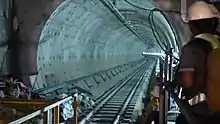
After a long planning and years of delay, Jakarta Mass Rapid Transit is currently in service. Jakarta city government decided for a rail-based system because of its ability to carry large numbers of people quickly and cheaply.[48] Jakarta MRT has a North–South line between Kota and Lebak Bulus and an East–West line. Preparation work started in April 2012,[49] and groundbreaking was done in October 2013. The first phase, between Bundaran HI and Lebak Bulus Grab began operations on 24 March 2019,[50] and the entire North–South line is scheduled to be operational by 2026.[51][52]
Jakarta LRT
Jakarta LRT is a light metro system currently under construction.[53] Eight two-cars trainsets were procured. The first phase of the LRT, from Velodrome to Pegangsaan Dua with six stations and a length of 5.8 kilometres (3.6 mi),[54] began commercial operations on 1 December 2019.[55]
Greater Jakarta LRT
Greater Jakarta LRT (LRT Jabodebek) is a light metro system which is currently under construction. The light rail transit (LRT) project was launched to replace the previously abandoned monorail project.[56] The groundbreaking ceremony was held on 9 September 2015, with the first phase of the construction will connect Harjamukti in Depok with Dukuh Atas in downtown Central Jakarta, passing through Cawang intersection. This phase will be 42.1 kilometres (26.2 miles) long, which includes 18 stations, and is expected to be operational by April 2021, after multiple delays.
Airport rail link
Soekarno-Hatta Airport Rail Link is a commuter train service connecting the Soekarno-Hatta International Airport to the BNI City in Central Jakarta.[57] Another express train service is now under planning stage to connect Soekarno-Hatta International Airport with Halim Perdanakusuma Airport. Completion of this line is expected to be in 2019 at the earliest.[58]
Air
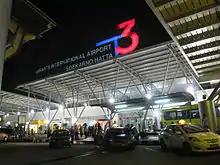
Soekarno–Hatta International Airport (CGK) is the main airport serving the Greater Jakarta area. The airport is named after the first President of Indonesia, Soekarno, and the first Vice President of Indonesia, Mohammad Hatta. The airport is often called Cengkareng airport or Soetta by Indonesians. The airport's IATA code, CGK, originates from the name of the Cengkareng locality, Tangerang, Banten, although the location of this airport is located outside of the city, it is used as a gate out by the Jakartans and citizen of the surrounding areas, therefore at the main gate of the airport, there is an inscription "Jakarta Airports".[59] Soekarno–Hatta International Airport was ranked as 17th busiest airport in the world by Airports Council International, with about 63 million passengers in 2017.[60] Today the airport is running over capacity. After T3 Soekarno-Hatta Airport expansion has finished in May 2016, the total capacity of three terminals become 43 million passengers a year. T1 and T2 also will be revitalised, so all the three terminals finally will accommodate 67 million passengers a year.[61]
A second airport, Halim Perdanakusuma Airport (HLP) serves domestic flight of low-cost airline, private and VIP/presidential flights. Other airports in the Jakarta metropolitan area include Pondok Cabe Airport and an airfield on Pulau Panjang, part of the Thousand Island archipelago (Kepulauan Seribu).
Waterway

Sea
Jakarta's main seaport Port of Tanjung Priok serves many ferry connections to different parts of Indonesia. Port of Tanjung Priok is Indonesia's busiest port, and the 21st busiest port in the world in 2013, handling over 6.59 million TEUs.[62] To boost the port capacity, two-phase "New Tanjung Priok" extension project is currently ongoing. When fully operational in 2023, it will triple existing annual capacity.
The port is also an important employer in the area, with more than 18,000 employees who provide services to more than 18,000 ships every year. The Port of Tanjung Priok has 20 terminals: general cargo, multipurpose terminal, scraps terminal, passenger terminal, dry bulk terminal, liquid bulk terminal, oil terminal, chemicals terminal and three container terminals, 76 berths, a quay length of 16,853 metres (55,292 feet), a total storage area of 661,822 square metres (7,123,790 square feet) and a storage capacity of 401,468 tonnes.[63]
The old port Sunda Kelapa only accommodate pinisi, a traditional two masted wooden sailing ship serving inter-island freight service in the archipelago. In December 2011, Muara Angke Port was renovated for Rp 130 billion ($14.4 million) in a 3 hectare area. Muara Angke Port is used as a public port to Thousand Islands, while Marina Ancol Port ia used as a tourist port.[64]
River
On 6 June 2007, the city administration introduced the Waterway (officially Angkutan Sungai), a new river boat service along the Ciliwung River.[9][65] Unfortunately, due of varying water levels during the dry and wet seasons in addition to floating plastic trashes that comes with water from upstream during raining, the service was closed.
See also
References
- Joe Cochrane (4 August 2013). "Hours to Go, Just to Get to Work: Indonesians Cope With Infuriating Traffic and Inefficient Public Transit". The New York Times. Retrieved 5 August 2013.
- "Jakarta wins global 2021 Sustainable Transport Award for integrated public transportation". The Jakarta Post. Retrieved 31 October 2020.
- "Transportation Issues and Future Condition in Tokyo, Jakarta, Manila and Hiroshima" (PDF). Retrieved 11 May 2010.
- "Pulo Gebang, Terminal Terbesar se-ASEAN Diresmikan 28 Desember". Liputan6. Retrieved 12 June 2017.
- "Pelabuhan Muara Angke Siap Digunakan". Retrieved 13 August 2020.
- "Jakarta Transportation Body Lays Out Strategies to Fix the Capital's $7b Traffic Problem". Jakarta Globe. Retrieved 11 December 2017.
- Technical Report Table 1.3.2 of the Study on Integrated Transportation Master Plan for Jabodetabek (SITRAMP), undertaken by Pacific Consultants International and ALMEC Corporation on behalf of the Indonesian National Development Planning Agency (BAPPENAS) and the Japan International Cooperation Agency (JICA), 2004,
- "United Nations Forum On Climate Change Mitigation, Fuel Economy And Sustainable Development Of Urban Transport" (PDF). Urban Public Transport System in Jakarta. Retrieved 1 December 2017.
- Williamson, Lucy (6 June 2007). "Jakarta begins river boat service". BBC News.
- "Jakarta's anti-macet policy". The Asean Post. Archived from the original on 8 January 2019. Retrieved 8 January 2019.
- "LRT or cable car? BPTJ plans mass transportation for Puncak tourist area". The Jakarta Post. Retrieved 4 December 2019.
- "Public Transportation Usage in Greater Jakarta Has Only Reached 30 Percent". Netral News. Archived from the original on 15 November 2019. Retrieved 15 November 2019.
- "1.38 million commute into Jakarta daily". The Jakarta Post. Retrieved 11 December 2017.
- Bachelard, Michael (4 February 2012). "Jakarta's jockeys in demand as gridlock drives city to despair". The Sydney Morning Herald. Retrieved 21 May 2018.
- "Urai Kemacetan, PR Terbesar Kapolda Metro". Archived from the original on 16 June 2015.
- "Odd-even policy working, decreasing traffic jams". The Jakarta Post. Retrieved 7 July 2017.
- "Jakarta Police request evaluation of odd-even policy". The Jakarta Post. Retrieved 7 July 2017.
- "10 districts prepared for electronic road pricing policy trial run in Jakarta". 2 September 2011. Archived from the original on 18 January 2012.
- "ERP will be implemented in Jakarta next year: Sandiaga". The Jakarta Post. Retrieved 24 March 2018.
- "Jakarta aims to introduce electronic road pricing in 2019". The Jakarta Post. Retrieved 25 March 2018.
- "Pulo Gebang, Terminal Terbesar se-ASEAN Diresmikan 28 Desember". Liputan6. Retrieved 12 June 2017.
- Azuma, Yoshifumi (2003). Urban peasants: beca drivers in Jakarta. Jakarta: Pustaka Sinar Harapan.
- Puspita, Sherly (17 January 2018). "Kehadiran Becak di Ibu Kota yang Diperdebatkan sejak Dulu..." Kompas (in Indonesian). Retrieved 28 May 2018.
- Amindoni, Ayomi (2018). "Becak di Jakarta dan 'kontrak politik' Gubernur Anies Baswedan". BBC Indonesia. Retrieved 1 April 2018.
- Zhacky, Mochamad (11 March 2018). "Becak di Jakarta Sudah Terdata, Anies: Jumlahnya Sekitar 1.500". detiknews (in Indonesian). Retrieved 23 May 2018.
- "Bajaj Oranye Menunggu Giliran Dimusnahkan". Republika Online (in Indonesian). 7 January 2016. Retrieved 26 May 2018.
- Wicaksono, Pebrianto Eko (11 April 2017). "Pakai CNG, Pengemudi Bajaj Dapat Banyak Manfaat". liputan6.com (in Indonesian). Retrieved 26 May 2018.
- Kunjana, L Gora (13 January 2016). "Bemo, Hidup Segan Mati Tak Mau". BeritaSatu.com (in Indonesian). Retrieved 23 May 2018.
- "Sudah Beroperasi di Jakarta, Ini Tarif Bajaj Roda Empat". Viva.co.id (in Indonesian). 23 July 2017. Retrieved 23 May 2018.
- Sugianto, Danang (8 October 2017). "Perusahaan Taksi di Jakarta Berguguran, Organda: dari 32 Sisa 4". Detikfinance. Retrieved 19 May 2018.
- Kristo, Fino Yurio (22 August 2017). "Awal Mula Transportasi Online Menjamur di Indonesia". detikinet (in Indonesian). Retrieved 28 May 2018.
- Sari, Nursita (28 May 2018). "Keluh Kesah Pengojek Sepeda Ontel Tatkala Menjamurnya Ojek "Online"..." Kompas (in Indonesian). Retrieved 28 May 2018.
- "Target 2020, Jalur Sepeda di Jakarta Mencapai 200 Kilometer". Kompas. Retrieved 2 November 2019.
- "New Bike-Sharing Service Set to Help Jakarta Combat Air Pollution, Traffic Congestion". Jakarta Globe. Retrieved 2 November 2019.
- "Japan loses Indonesian high-speed railway contract to China". The Japan Times Online. 30 September 2015. ISSN 0447-5763. Retrieved 7 July 2017.
- Vincencia NLS (2 October 2015). "China Railway Construction Corp to form JV with Indonesia's Wijaya Karya for $5.5b HST". Deal Street Asia. Retrieved 7 July 2017.
- Post, The Jakarta. "Japan selected as partner for Jakarta-Surabaya railway project". The Jakarta Post. Retrieved 7 July 2017.
- Lo, Ria Hutabarat (5 November 2009). "The City as a Mirror: Transport, Land Use and Social Change in Jakarta". Urban Studies. 47 (3): 529–555. doi:10.1177/0042098009348557.
- "Best Practice: Bus Rapid Transit (BRT) System" (PDF). NYC Global Partners’ Innovation Exchange. 4 May 2012. Retrieved 19 May 2018.
- "Koridor". Transjakarta.
- "Transjakarta operates new Palmerah Station-Senayan traffic circle route". The Jakarta Post. Retrieved 26 April 2018.
- "With more buses on the streets, a surge in Transjakarta passengers".
- Sudibya (2007). Pengembangan Restrukturisasi PT Kereta Api (Persero) Divisi Angkutan Perkotaan Jabotabek [Development of Restructuring of PT Kereta Api (Persero) Jabotabek Urban Transport Division] (PDF) (Thesis) (in Indonesian). Semarang: Diponegoro University. Archived (PDF) from the original on 2 April 2015. Retrieved 14 March 2011.
- "Number of Train Passengers, 2006 – 2014". Statistics Indonesia. Badan Pusat Statistik. Archived from the original on 10 March 2015. Retrieved 10 March 2015.
- "Commuter line passengers hits 1 million".
- "Jakarta's Commuter Line Train Gets Ready for More Passengers in 2018".
- Ravel, Stanly (1 February 2018). "Manggarai Jadi Stasiun Tersibuk di Indonesia". Kompas (in Indonesian). Retrieved 22 May 2018.
- "Rail-based Transportation, Main Component of Metropolitan City". Berita Jakarta. Archived from the original on 28 July 2012. Retrieved 16 June 2011.
- Preparation work for MRT begins|The Jakarta Post
- Bernhart Farras & Chandra Gian Asmara (24 March 2019). "Resmikan MRT Jakarta, Jokowi: Sebuah Peradaban Baru Dimulai".
- "MRT Jakarta". www.jakartamrt.co.id. Archived from the original on 6 October 2016. Retrieved 5 October 2016.
- "City launches two busway routes". The Jakarta Post. Retrieved 14 March 2011.
- "Rencana LRT di Jakarta". Kompas (in Indonesian). Jakarta. 11 September 2015. Retrieved 21 September 2015.
- Media, Kompas Cyber (24 August 2018). "Kemenhub Lakukan Operasional Terbatas untuk LRT Kelapa Gading - Kompas.com". KOMPAS.com (in Indonesian). Retrieved 7 September 2018.
- Yuliani, Putri Anisa (5 December 2019). "Sudah Berbayar, Jumlah Penumpang LRT Jakarta Menurun". Media Indonesia (in Indonesian). Retrieved 11 June 2020.
- "Ahok confirms cancellation of monorail project". The Jakarta Post. Jakarta. 10 September 2015. Retrieved 21 September 2015.
- "Airport train kicks off services with promotional fare". The Jakarta Post. Retrieved 26 December 2017.
- "Pemerintah Kaji Ulang Kontrak KA Ekspres Halim-Soetta". 6 December 2017.
- "Tol Bandara Dijamin Tidak Banjir". Poskotanews (in Indonesian). 12 January 2012. Retrieved 14 December 2016.
- "List: The world's 20 busiest airports (2017)". USA TODAY. Retrieved 2 May 2018.
- Pingkan Elita Dundu (17 November 2014). "Agar Penumpang Lebih Aman dan Nyaman di Bandara Soekarno-Hatta". Kompas (in Indonesian). Retrieved 14 December 2016.
- http://www.worldshipping.org Top 50 world container ports
- Port of Jakarta facilities
- "Pelabuhan Muara Angke Siap Digunakan". Retrieved 9 December 2011.
- "Jakarta gets its first klong taxis". Bangkok Post. The Post Publishing Public Co. Archived from the original on 18 January 2008.